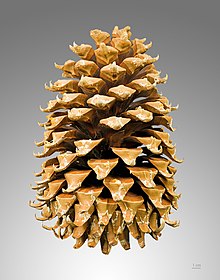
Back مخروط صنوبري Arabic Tschurtsch BAR Kankuoriežis BAT-SMG Шышка Byelorussian Шышка BE-X-OLD Шишарка Bulgarian Šišarka BS Estròbil Catalan Šiška Czech Йĕкел (стробил) CV
This article needs additional citations for verification. (June 2009) |



A conifer cone or pinecone (strobilus, pl.: strobili in formal botanical usage) is a seed-bearing organ on gymnosperm plants. It is usually woody, ovoid to globular, including scales and bracts arranged around a central axis, especially in conifers and cycads. The cone of Pinophyta (conifer clade) contains the reproductive structures. The woody cone is the female cone, which produces seeds. The male cone, which produces pollen, is usually herbaceous and much less conspicuous even at full maturity. The name "cone" derives from Greek konos (pine cone), which also gave name to the geometric cone. The individual plates of a cone are known as scales. The umbo of a conifer cone refers to the first year's growth of a seed scale on the cone, showing up as a protuberance at the end of the two-year-old scale.[citation needed]
The male cone (microstrobili or pollen cone) is structurally similar across all conifers, differing only in small ways (mostly in scale arrangement) from species to species. Extending out from a central axis are microsporophylls (modified leaves). Under each microsporophyll is one or several microsporangia (pollen sacs).
The female cone (megastrobilus, seed cone, or ovulate cone) contains ovules which, when fertilized by pollen, become seeds. The female cone structure varies more markedly between the different conifer families, and is often crucial for the identification of many species of conifers.
© MMXXIII Rich X Search. We shall prevail. All rights reserved. Rich X Search